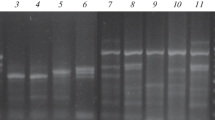Abstract
A 998 bp fragment of plasmid pBR322, comprising part of the TEM-1β-lactamase gene, was labelled with biotin-11-dUTP for use as a DNA probe in a rapid non-isotopic spot hybridisation test. Diluted broth cultures of bacteria producing differentβ-lactamases were filtered onto nitrocellulose and lysed in situ. Following pre-hybridisation treatment with proteinase K, hybridisation with the labelled probe was demonstrated using a commercially available strep tavidine/poly alkaline phosphatase-based detection system. The probe was highly specific, reacting only with strains producing either the TEM-1 or structurally similar TEM-2 enzyme. An inoculum of 3–4 × 106 cells gave optimum positive discrimination. When 90 recent ampicillin-resistant strains ofEscherichia coli isolated from patients with urinary tract infections were screened using the system, 72% gave a positive hybridisation signal.
Similar content being viewed by others
References
Tenover, F. C.: Studies of antimicrobial resistance genes using DMA probes. Antimicrobial Agents and Chemotherapy 1986, 29: 721–725.
Tenover, F. C., Gootz, T. D., Gordon, K. P., Tompkins, L. S., Young, S. A., Plorde, J. J.: Development of a DNA probe for the structural gene of the 2′-0-adenyltransferase aminoglycoside-modifying enzyme. Journal of Infectious Diseases 1984, 150: 678–687.
Mayer, K. H., Fling, M. E.: Trimethoprim resistance in multiple genera ofEnterobacteriaceae at a U.S. hospital: spread of the type II dihydrofolate reductase gene by a single plasmid. Journal of Infectious Diseases 1985, 151: 783–789.
Gootz, T. D., Tenover, F. C., Young, S. A., Gordon, K. P., Plorde, J. J.: Comparison of three DNA hybridisation methods for detection of the aminoglycoside 2′-0-adenyl transferase gene in clinical bacterial isolates. Antimicrobial Agents and Chemotherapy 1985, 28: 69–73.
Chaslus-Dancla, E., Gerbaud, G., Lafont, J. P., Martel, J. L., Courvalin, P.: Nucleic acid hybridisation with a probe specific for 3-aminoglycoside-acetyltransferase type IV: a survey of resistance to apramycin and gentamicin in animal strains ofEscherichia coli. FEMS Microbiology Letters 1986, 34: 265–268.
Langer, P. R., Waldrop, A. A., Ward, D. C.: Enzymatic synthesis of biotin-labelled polynucleotides: novel nucleic acid affinity probes. Proceedings of the National Academy of Sciences of the United States of America 1981, 78: 6633–6637.
Leary, J. J., Brigati, D. J., Ward, D. C.: Rapid and sensitive colorimetric method for visualising biotin-labelled DNA probes hybridised to DNA or RNA immobilised on nitrocellulose: Bioblots. Proceedings of the National Academy of Sciences of the United States of America 1983, 80: 4045–4049.
Simpson, I. N., Knothe, H., Plested, S. J., Harper, P. B.: Qualitative and quantitative aspects ofβ-lactamase production as mechanisms ofβ-lactam resistance in a survey of clinical isolates from faecal samples. Journal of Antimicrobial Chemotherapy 1986, 17: 725–737.
Cooksey, R. C., Clark, N. C., Thornsberry, C.: A gene probe for the TEM typeβ-lactamases. Antimicrobial Agents and Chemotherapy 1985, 28: 154–156.
Maniatis, T., Fritsch, E. F., Sambrook, J.: Molecular cloning: a laboratory manual. Cold Spring Harbor Laboratory, New York, 1982, p. 314, 382–389.
Silhavy, T. J., Berman, M. L., Enquist, L. W.: Experiments with gene fusions. Cold Spring Harbor Laboratory, New York, 1984, p. 191–195.
Ambler, R. P., Scott, G. K.: Partial amino acid sequence of penicillinase coded byEscherichia coli plasmid R6K. Proceedings of the National Academy of Sciences of the United States of America 1978, 75: 3732–3736.
Sutcliffe, J. G.: Nucleotide sequence of the ampicillin resistance gene ofEscherichia coli plasmid pBR322. Proceedings of the National Academy of Sciences of the United States of America 1978, 75: 3737–3741.
Ouellette, M., Roy, P. H.: Analysis by using DNA probes of the OXA-1β-lactamase gene and its transposon. Antimicrobial Agents and Chemotherapy 1986, 30: 46–51.
Rubin, L. G., Medeiros, A. A., Yolken, R. H., Moxon, E. R.: Ampicillin treatment failure of apparentlyβ-lactamase-negativeHaemophilus influenzae type b meningitis due to novelβ-lactamase. Lancet 1981, ii: 1008–1010.
Simpson, I. N., Plested, S. J., Budin-Jones, M. J., Lees, J., Hedges, R. W., Jacoby, G. A.: Characterisation of a novel plasmid-mediatedβ-lactam resistance inPseudomonas aeruginosa. FEMS Microbiology Letters 1983, 19: 23–27.
Medeiros, A. A., Cohenford, M., Jacoby, G. A.: Five novel plasmid-determinedβ-lactamases. Antimicrobial Agents and Chemotherapy 1985, 27: 715–719.
Simpson, I. N., Harper, P. B., O'Callaghan, C. H.: Principalβ-lactamases responsible for resistance toβ-lactam antibiotics in urinary tract infections. Antimicrobial Agents and Chemotherapy 1980, 17: 929–936.
Author information
Authors and Affiliations
Rights and permissions
About this article
Cite this article
Carter, G.I., Towner, K.J. & Slack, R.C.B. Detection of TEM beta-lactamase genes by non-isotopic spot hybridisation. Eur. J, Clin. Microbiol. 6, 406–409 (1987). https://doi.org/10.1007/BF02013095
Issue Date:
DOI: https://doi.org/10.1007/BF02013095




